Category: Benedictine saints & blesseds
Saint Gertrude the Great and the Sacred Heart
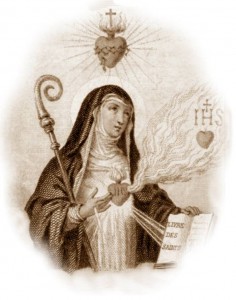 “O Sacred Heart of Jesus, fountain of eternal life, Your Heart is a glowing furnace of Love. You are my refuge and my sanctuary. O my adorable and loving Saviour, consume my heart with the burning fire with which Yours is aflamed. Pour down on my soul those graces which flow from Your love. Let my heart be united with Yours. Let my will be conformed to Yours in all things. May Your Will be the rule of all my desires and actions. Amen.”
“O Sacred Heart of Jesus, fountain of eternal life, Your Heart is a glowing furnace of Love. You are my refuge and my sanctuary. O my adorable and loving Saviour, consume my heart with the burning fire with which Yours is aflamed. Pour down on my soul those graces which flow from Your love. Let my heart be united with Yours. Let my will be conformed to Yours in all things. May Your Will be the rule of all my desires and actions. Amen.”
~St. Gertrude the Great
Benedictine All Saints
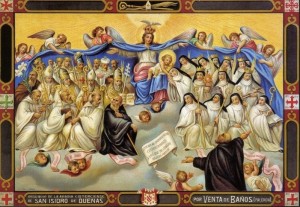 We of the Benedictine family traditionally celebrate the feast of All Saints of the Benedictine Order — In Festo Omnium Sanctorum Ordinis S.P.N. Benedicti.
We of the Benedictine family traditionally celebrate the feast of All Saints of the Benedictine Order — In Festo Omnium Sanctorum Ordinis S.P.N. Benedicti.
The Cistercians –who likewise follow the Rule of St. Benedict, observe this day for All Saints of their Order.
The Introit of the feast reads:
“Let us all rejoice in the Lord, celebrating a festival in honour of all the saints who did battle under the Rule of Saint Benedict, at whose solemnity the Angels rejoice and all together praise the Son of God.”
Through intercession of all the Benedictine saints, let us pray for that our brothers and sisters throughout the world (the nuns, monks, and oblates) living under the Rule of Saint Benedict,
may persevere in daily seeking the face of God; thus giving the Holy Trinity praise day and night.
“Avete Solitudinis Claustrique Mites”
Hail dwellers in the solitude
And in the lowly cloister cell,
Who steadfast and unshaken stood
Against the raging hordes of hell.
All wealth of gold and precious stone
And glories all of rank and birth
You cast away and trampled on,
With all low pleasures of this earth.
The green fields and the orchards grew
The simple fare whereon ye fed.
The brook was drink enough for you,
And on the hard ground was your bed.
Around you dwelt the venomed snakes,
And fiercest monsters harboured near.
All foul forms that the demon takes
You saw, but would not yield to fear.
Far, far beyond all earthly things
Your burning thoughts would wing their flight,
And hear the holy whisperings
Of angels in the heavenly height.
Thou Father of the heavenly host,
Thou glorious Son of Mary maid,
Thou Paraclete, the Holy Ghost,
To Thee be praise and glory paid.
~text found in the Breviaries Monasticum until 1963, and in the Breviaries Cisterciense.
Blessed Herman the Cripple
Blessed Ildefonso Schuster, OSB
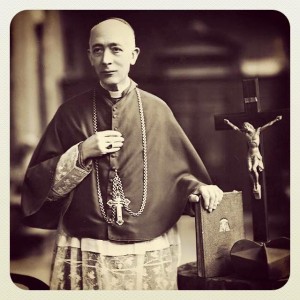 The Benedictine monk, abbot, bishop and Cardinal is honored on this date: Blessed Alfredo Ildefonso Schuster. As a Roman by birth, he was a professed Benedictine monk and later abbot of the Abbey of Saint Paul outside the Walls (Rome). He was a liturgical scholar and professor at Sant’Anselmo.
The Benedictine monk, abbot, bishop and Cardinal is honored on this date: Blessed Alfredo Ildefonso Schuster. As a Roman by birth, he was a professed Benedictine monk and later abbot of the Abbey of Saint Paul outside the Walls (Rome). He was a liturgical scholar and professor at Sant’Anselmo.
“The Church’s Liturgy may…be considered as a sacred poem, in the framing of which both heaven and earth have taken part, and by which our humanity, redeemed in the blood of the Lamb without spot, rises on the wings of the Spirit even unto the throne of God himself. This is more than a mere aspiration, for the Sacred Liturgy not only shows forth and expresses the ineffable and the divine, but also, by means of the sacraments and of its forms of prayer, develops and fulfils the supernatural in the souls of the faithful, to whom it communicates the grace of redemption. It may even be said that the very source of holiness of the Church is fully contained in her Liturgy; for, without the holy sacraments, the Passion of our Lord, in the existing dispensation instituted by almighty God, we would have no efficacy in us, since there would be no channels capable of conveying its treasure to our souls.”
ldefonso Schuster, The Sacramentary, vol. I (Burns, Oates & Washbourne, London, 1923) p. 3.
Saint Bernard of Clairvaux
 Saint Bernard of Clairvaux composed the famous prayer to the Most Blessed Virgin Mary known as The Memorare. This year is Bernard’s 900th anniversary!
Saint Bernard of Clairvaux composed the famous prayer to the Most Blessed Virgin Mary known as The Memorare. This year is Bernard’s 900th anniversary!
MEMORARE, O piissima Virgo Maria, non esse auditum a saeculo, quemquam ad tua currentem praesidia, tua implorantem auxilia, tua petentem suffragia, esse derelictum. Ego tali animatus confidentia, ad te, Virgo Virginum, Mater, curro, ad te venio, coram te gemens peccator assisto. Noli, Mater Verbi, verba mea despicere; sed audi propitia et exaudi. Amen.
REMEMBER, O most gracious Virgin Mary, that never was it known that anyone who fled to thy protection, implored thy help, or sought thy intercession was left unaided. Inspired with this confidence, I fly to thee, O Virgin of virgins, my Mother; to thee do I come; before thee I stand, sinful and sorrowful. O Mother of the Word Incarnate, despise not my petitions, but in thy mercy hear and answer me. Amen.
St Benedict
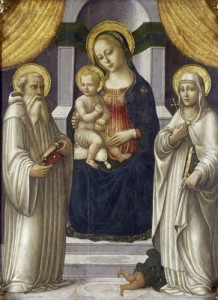 Today, the Church honors Saint Benedict (the Translation of the Relics, not the Transitus which is celebrated in March), Patron of Europe. Those over at the Miraculous Medal apostolate have proposed this prayer to Benedict. Every Benedictine monk, nun, sister and oblate has a sincere devotion the Blessed Mother.
Today, the Church honors Saint Benedict (the Translation of the Relics, not the Transitus which is celebrated in March), Patron of Europe. Those over at the Miraculous Medal apostolate have proposed this prayer to Benedict. Every Benedictine monk, nun, sister and oblate has a sincere devotion the Blessed Mother.
Dear Saint Benedict, You are a ‘blessing’ indeed, as your name indicates. Practicing what you preached, you founded the monastic tradition of the West by joining prayer to labor for God – both liturgical and private prayer. Help all religious to follow their Rule and be true to their vocation. May they labor and pay for the world to the greater glory of God.
God our Father, You made St. Benedict an outstanding guide to teach men how to live in Your service. Grant that by preferring Your love to everything else, we may walk in the way of Your commandments. We ask this through Christ our Lord. Amen.
O Mary, conceived without sin, pray for us who have recourse to thee.
Saint Bede, the Venerable
We honor the memory of a venerable Benedictine monk and Churchman, Saint Bede. He is the only English Doctor of the Church and a fine example of monastic learning and holiness. Most people relate to him as the historian of the English Church because of his famous work, Historia Ecclesiastica.
Christ was his King. No other lord
Did Bede aspire to serve.
No other love could claim the heart
He gave without reserve.
From boyhood onward his delight
Was in the scriptures found,
Or singing praise to him who hung
Upon the Rood, thorn-crowned.
Like Easter night, Bede’s quiet cell
Saw Christ arising there;
And when Ascension dawned at last
The Son shone bright and fair.
To Christ the King of glory sing,
And God the Father praise,
Whose Spirit dwells in peaceful hearts
And guides them in his ways.
The text is an ancient monastic hymn. It was translated by Dame Catherine of Holy Trinity Monastery, Herefordshire, UK.
Saint Benedict
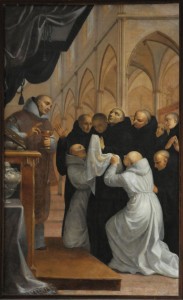 Saint Benedict, [the Father of Western Monasticism (480-543)] blessed by grace as his prophetic name seemed to foretell, was born of a noble Italian family in Umbria, in the year 480. As a boy he showed great inclination for virtue, and maturity in his actions. He was sent to Rome at the age of seven, to be placed in the public schools. At the age of fourteen, alarmed by the licentiousness of the Roman youth, he fled to the desert mountains of Subiaco, forty miles from Rome, and was directed by the Holy Spirit into a deep, craggy, and almost inaccessible cave, since known as the Holy Grotto. He lived there for three years, unknown to anyone save a holy monk named Romanus, who clothed him with the monastic habit and brought him food.
Saint Benedict, [the Father of Western Monasticism (480-543)] blessed by grace as his prophetic name seemed to foretell, was born of a noble Italian family in Umbria, in the year 480. As a boy he showed great inclination for virtue, and maturity in his actions. He was sent to Rome at the age of seven, to be placed in the public schools. At the age of fourteen, alarmed by the licentiousness of the Roman youth, he fled to the desert mountains of Subiaco, forty miles from Rome, and was directed by the Holy Spirit into a deep, craggy, and almost inaccessible cave, since known as the Holy Grotto. He lived there for three years, unknown to anyone save a holy monk named Romanus, who clothed him with the monastic habit and brought him food.
He was eventually discovered, when, one Easter day, God advised a priest who lived about four miles from there, to take food to His servant, who was starving. The priest searched in the hills and finally found the solitary, and they took their meal together. Some shepherds also knew of his retreat, and soon the fame of this hermit’s sanctity began to spread. The demon persecuted him, but to no avail; when a temptation of the flesh assailed him, he rolled in a clump of thorns and nettles, and came out of it covered with blood but sound in spirit.
Disciples came to him, and under his direction, numerous monasteries were founded. The rigor of the rule he drew up, however, brought upon him the hatred of some of the monks, and one of them mixed poison with the Abbot’s drink. When the Saint made the sign of the cross on the poisoned bowl, it broke and fell in pieces to the ground.
Saint Benedict resurrected a boy whose father pleaded for that miracle, saying Give me back my son! He replied, Such miracles are not for us to work, but for the blessed apostles! Why will you lay upon me a burden which my weakness cannot bear? But finally, moved by compassion, he prostrated himself upon the body of the child, and prayed: Behold not, O Lord, my sins, but the faith of this man, and restore the soul which Thou hast taken away! And the child rose up, and walked to the waiting arms of his father. When a monk lost the iron head of his axe in a river, the Abbot told him to throw the handle in after it, and it rose from the river bed to resume its former place.
Six days before his death, Saint Benedict ordered his grave to be prepared, then fell ill of a fever. On the sixth day he asked to be carried to the chapel, and, having received the sacred Body and Blood of Christ, with hands uplifted and leaning on one of his disciples, he calmly expired in prayer, on the 21st of March, 543.
Reflection. The Saints never feared to undertake any work for God, however arduous, because distrusting self they relied for assistance and support wholly upon prayer.
Little Pictorial Lives of the Saints, a compilation based on Butler’s Lives of the Saints and other sources by John Gilmary Shea (Benziger Brothers: New York, 1894); Les Petits Bollandistes: Vies des Saints, by Msgr. Paul Guérin (Bloud et Barral: Paris, 1882), Vol. 3
Martyrs of Viaceli
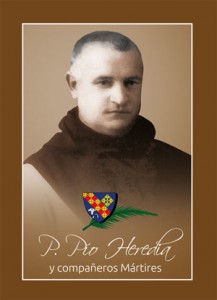 Angelo Cardinal Amato, SDB, prefect of the Congregation for the Causes of Saints presented to Pope Francis a degree regarding the martyrdom of the Servants of God Pio Heredia and 17 Companions, monks and nuns of the Cistercian Order of the Strict Observance (Trappists) and of the Congregation of San Bernard. The designation of martyr means that a determination was made that they were killed in hatred of the faith during the Spanish Civil War (1936-1939).
Angelo Cardinal Amato, SDB, prefect of the Congregation for the Causes of Saints presented to Pope Francis a degree regarding the martyrdom of the Servants of God Pio Heredia and 17 Companions, monks and nuns of the Cistercian Order of the Strict Observance (Trappists) and of the Congregation of San Bernard. The designation of martyr means that a determination was made that they were killed in hatred of the faith during the Spanish Civil War (1936-1939).
The beatification is Saturday, October 3, 2015 in the cathedral of Santander, Cantabria, Spain.
The Cistercians consider the martyrdom of their brothers as a testimony to the Sermon on the Mount where our Lord, “Blessed are the peacemakers, for they shall be called sons of God.” Their death is a great witness “To prefer nothing to the love of Christ.” And, they did so in silence.
The beatification cause of the Cistercian Mother María Micaela Baldoví Trull, 67 and Mother María Natividad Medes Ferris, 56, Monastery of Fons Salutis, in Algemesí
Father Pio and the monks were professed at the Monasterio de Santa María de Viaceli. Here is the list of the monks:
Father Pío Heredia Zubía, 61 years
Father Amadeo García Rodríguez, 31 years
Father Valeriano Rodríguez García, 30 years
Father Juan Bautista Ferris Llopis, 31 years
Father Eugenio García Pampliega, 33 years
Father Vicente Pastor Garrido, 31 years
Brother Álvaro González López, 21 years
Brother Marcelino Martín Rubio, 23 years
Brother Antonio Delgado González, 21 years
Brother Eustaquio García Chicote, 45 years
Brother Ángel de la Vega González, 68 years
Brother Ezequiel Álvaro de la Fuente, 19 years
Brother Eulogio Álvarez López, 20 years
Brother Bienvenido Mata Ubierna, 28 years
Brother Leandro Gómez Gil, 21 years.

